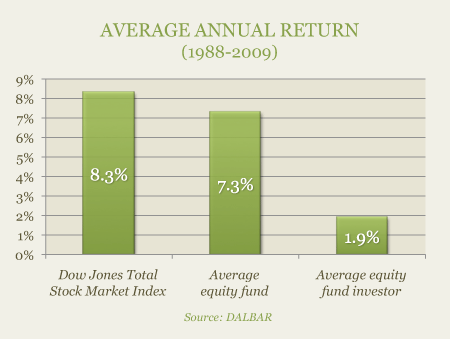The Biggest Mistake Investors Make
The mutual fund manager was a stock-picking savant who churned out staggering returns with remarkable regularity. In his fund's first seven years, he delivered a 285 percent cumulative return — nearly twice that of his peers. The New Yorker pronounced him "the stock market's certified golden boy." Investors' money, of course, poured in.
Then at the height of the manager’s fame, he struck out on his own, and overnight, his new fund became one of the largest. But just as suddenly as the sun had risen on this superstar, it began to set. After returning 39 percent in its first year, the fund faltered. Eight years after launch, it had lost a total of 70 percent ― the worst in mutual fund industry.
The genius-turned-goat was Gerald Tsai, manager of the Fidelity Capital Fund from 1958 to 1965 and then the Manhattan Fund. The pattern is one played out time and again with managers of mutual funds, investment advisers, and the like: Guru strings together a few years of outstanding performance, investors rush in, assets under management soar, performance deteriorates, and disappointed investors file out to begin the search anew. One of the biggest mistakes an investor can make is to chase performance. Because Wall Street’s dirty little secret is that there is no silver bullet — no magic trick — that makes one fund manager a genius.
The Problem with Performance Chasing
Investors have a long infatuation with past performance. Short-term returns of six months to three years can be particularly compelling, because they are often so remarkable. But they’re terrible predictors of what the future holds. That fact was highlighted nicely in a recent Morningstar article that examined the investor returns of the CGM Focus fund, which rocketed in 2007 and crashed to earth in 2008.
Some investors turn their attention to long-term winners, funds that have demonstrated their superiority over a decade or so. But long-term returns turn out to be poor indicators of future results, too. Consider the records of the 20 top-performing funds from the 1970s, ’80s, and ’90s. In each case, the highfliers outpaced both their peers (by 5 to 8 percent annually) and the Standard & Poor’s 500 index (by 3 to 6 percent annually) during their hot decades. Cash flow into the funds was staggering and, most importantly, increased markedly in the second half of each decade, as investors piled in to avoid missing the action.
And then ... well, you can guess what’s happened since.
The average top 20 fund from each of those decades has lagged both the S&P 500 and its peers through August 2009. Winners in the 1970s have trailed the index by 1.3 percent annually, and their peers by 0.6 percent; 1980s’ winners were behind both the index and peers by 0.6 percent; and 1990s’ winners underperformed by 4.5 percent and 2.3 percent, respectively. And those data don’t reflect the records of the decades’ top funds that have since been closed or merged. If their (doubtless terrible) subsequent performance was included, the gap would be wider.
The bad news doesn’t end there: Most investors in those top 20 funds fared even worse than the funds’ returns would suggest. Clambering aboard only after the great gains had been achieved, they missed the upside and bore the brunt of the downside as the funds’ returns fell. For the 20 years ended 2008, the Dow Jones Total Stock Market Index has provided an annual return of 8.3 percent. The average equity fund has earned 7.3 percent. The average equity fund investor? According to Dalbar, poor timing and suspect decision-making reduced his return to a mere 1.9 percent. To put that in even starker relief, each dollar invested in the index 20 years ago would now be worth $4.95; in the average equity fund, it would be worth $4.06; and the average equity fund investor’s dollar would be worth $1.45, representing just 11 percent of the growth provided by the market index.
As Warren Buffett’s investing partner Charlie Munger has said: “Successful funds attract a massive amount of money, and the later performance typically gets mediocre. Then they keep publishing returns for the whole period for someone who started 20 years ago ... The reporting has falsehood and folly in it.”
One of the most famous mutual funds is an excellent example. “If you take something like Fidelity Magellan, which Peter Lynch ran terrifically, a lot of results were achieved with smaller amounts,” added Buffett. A few early investors made out brilliantly, but most were late to the party.
Why Won’t Investors Learn?
All of which begs the obvious question: Why? Why do investors continually engage in behavior that almost always proves destructive — searching for the Holy Grail in a money manager?
The answer, with apologies to Joan Didion, is largely due to the stubborn persistence of magical thinking. Instead of accepting the evidence that it’s nearly impossible for investment pros to add value over the long term, many investors want to believe that someone somewhere has it all figured out. And simply by identifying that person and handing over money, they think, their financial worries will be over.
At its extreme, there’s no better illustration of magical thinking than the Bernie Madoff saga. He was the ultimate exclusive money manager. Rumors of his brilliance circulated around elite country clubs for years, and investors begged him to work his magic and spin their money into gold. Due diligence? That was for suckers. After all, famous and successful people like former Salomon Brothers Chief Economist Henry Kaufman, Sen. Frank Lautenberg, and the actor John Malkovich invested with Bernie.
Whether you are more likely to swap investment tips with friends at neighborhood parties or with bridge partners at the Palm Beach Country Club, you’re no less immune from the same type of magical thinking that led otherwise smart people to believe Madoff could churn out consistently high returns year after year.
If Not Magic, What?
The brutal truth is that there is no magic in investing, no brilliant manager ready to transform your savings into a retirement El Dorado. At any given time, some fund manager will lead the top-performing list and another will be at the bottom. But odds are that the records of today’s winners are attributable mostly to luck and perhaps fortunate timing ― value stocks may happen to be in favor right now, for example. And history shows that the next list of winners probably will look nothing like today’s.
So What’s an Investor to Do?
- Focus on expenses. There is no greater correlation to your long-term returns than your investment fees. The less you pay, the more you keep.
- Seek stability. A manager with decades of experience working for a firm with a history of prudent trusteeship is most able to guide you through whatever the market does in the years ahead.
- Focus on the long term. Successful investing is about slow and steady accumulation of assets over time. Don’t be captivated by the latest know-it-all managers bloviating on CNBC who were unknowns a month ago. Where will they be when you really need them?
- Stop Listening to Jim Cramer
- Ignore the Mutual Fund Horse Race
- Tough Questions for Your Financial Adviser
- Tips on Choosing an Actively Managed Fund
You could eschew active money management in favor of a broad market index fund. The logic behind an index fund’s approach is simple, mathematically indisputable, and bolstered by decades of real-world experience: Minimize your investment expenses and earn the market return, which will outpace most active managers over the long term.
If you feel compelled to use actively managed funds, however, look for a strong (and lengthy) track record and take these three steps to help ensure that your choice is grounded more in logic than in magical thinking:
More on MoneyWatch:

